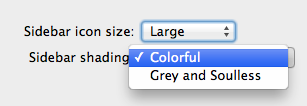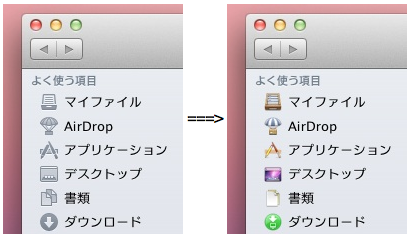
And a poor attempt at a Jedi mind trick at that. With the now grey and lifeless sidbar in Lion Apple is trying to visually say: “these aren’t the files or folders you’re looking for”. It’s as if they want us to become so turned-off to this grey apocalyptic version of the sidebar that we yearn for iCloud where our data lives in the apps and those pesky file and folder structures cease to have any relevance in our workflow.
Reality check Apple, you won’t change our habits overnight, nor overturn what is a completely valid way of working with your computers. You will not endear us to the iCloud experience by also crippling the Finder’s look and feel. Although I do thank you for returning the ability to have large icons in the sidebar, which you took away in 10.5, the grey-ification of the icons and the exile of Devices to the bottom of the list has truly hobbled any usefulness the Finder had. Oh, add the fact that mounted volumes no longer show as a Device, but rather you have to add them manually to favorites has also irked me. Why should I have to open up Shared, click the server then find the volume I want. It’s ridiculous when you couple that with having the default Finder behavior to not show mounted volumes on the desktop. Fine you hate files, folders and drives, we get it, but not all of us agree… “the rest of us”, as it were.
Here’s a compromise I could live with Apple:

Thankfully, a very bright Mac developer has made a plugin to return color to the Finder sidebar. Now I normally do not like using SIMBL plugins because code injection and method swizzling makes me nervous. But having color on the sidebar is worth it. You can find all the info for doing this at OS X Daily along with installation tips.

So, file those Bug Reports with Apple and let them know their Jedi mind trick isn’t going to work. These are the files and folders we’re looking for and color would greatly help us find them. (I’d consider this a regression fix rather than a feature request.)
Postscript on (not) using Finder:
A quick note for the purists out there who don’t even run Finder. You intrepid folks take a road less travelled but not one that not everyone wants to embark down. Now, Rick of Rixstep will argue that Finder is an and abhorrent holdover from OS 9 that should have gotten the axe or at the least been completely recoded into 100% Cocoa, all of its Carbon cruft put out to pasture, its very existence is retarding OS X, and to run Finder on your system is akin to self-trepanation. OK — fair enough actually on most points! :D However, until someone else comes along with a Finder replacement that is 100% Cocoa and has full feature parity, then we put up with the Finder. (And most businesses would be loathe to spend money on licenses for Finder replacements like XFile or PathFinder, it’s hard enough to get them to spend the extra dough up-front for a Mac!) Wah wah :/ So we commiserate with others on the discussion boards and plead our case to the Designers Gone Wild at Apple.
Not using Finder is not about purism. It’s about not running crap.
The purpose of the highlight on Cocoa code should be apparent to all adepts: they took a perfectly good system and ruined it for no better reason than beige box beards were whinging there wasn’t an app called ‘Finder’ anymore. They didn’t even notice that the first rewrite was functionally equivalent to File Viewer. That’s the caliber of people you’re dealing with. Or applying for membership with.
Apple themselves called it ‘notorious’ in a job placement ad. It’s commonly called ‘TFF’ both by people who have the chops to understand and by others who don’t have a clue.
Apple have no obligation to give you the best of the best of user land apps. They don’t and most vendors don’t. Expecting that bespeaks a lack of experience in the industry. What they do have an obligation to give you are the full APIs so you can make your own tools. For their job is solely to provide you with the best operating system they can. That and no more.
As for ‘feature parity’, that’s best left for now. Trying to match TFF in its so-called ‘features’ is ludicrous. No one wants them! They want to get the job done! They want full access to their systems! They want to get into all areas of the HDD, and not be blocked out because Finder can’t read certain directories! And so forth and so on. You know well enough because you’ve been using the product since 2005 or so.
But you’re right about corporations not relishing the idea of shelling out more because something in the Apple system lets them down. They’ve witnessed this for over ten years now and there’s no change in sight.
This is evidenced by the fact that the enterprise shuns Apple for precisely that reason. There’s also the lack of a sensible exit strategy, but that’s just part of the same ridiculous situation.
What’s really amusing is how you seem to be asking third party to reach a ‘feature parity’ with TFF. How about the other way around?
TFF won’t show you full file permissions nor will it offer you the granularity already available in the ‘Rock Solid Foundation’. It’s been dumbed down for end users. Admins have no way around this. You can’t set executable bits. You can’t get at system and user flags. You have no interface for managing extended attributes. You have no interface for managing access control lists. You can’t see the four time stamps on files. You can’t distinguish between actual file size and the gunk Apple put on your files. You have no way of managing the gunk or getting rid of it. You have no way to navigate to important areas of your disk such as /dev. TFF can’t even get in there.
That’s good enough for starters. That’s not a list of features Xfile has – that’s a list of features that are absolutely necessary for any file manager used in a professional way. Worrying about the colours of icons is – well it’s typical Maccie talk. Start by getting TFF to achieve ‘feature parity’ with every other self-respecting file manager on the planet. It’s not just Xfile – it’s Microsoft’s Explorer, it’s the file managers for GNOME and KDE, it’s all those products. There are differences between them but they have one thing in common: they’re not built in Lego by freaks. Don’t forget that Apple turned their backs on the enterprise. This of course long after it was apparent – for the above reasons and more – that the enterprise would never be interested in silly Apple.
Feature parity? Yeah right. Making a plugin to put colours back in? That’s the level of third party development that’s made OS X so notorious. Corporations and their techies see that and they run for it. As a client of ours who’s big in the networking game put it a few years ago:
‘They show you their fabulous servers. You drool. They show you all the utilities they give you. You drool more. Then you ask them to show you the file manager and they show you TFF. Then you laugh and walk away.’
But that’s the experience of a real pro who’s been around the block a few times and is currently at the top of his game. Your experiences may differ.
People want the safety of Unix. But they also want freedom of choice. And that includes and exit strategy. Something Apple will never give them, despite heated promises for several years at the end of the last millennium. They also demand adequate tools. They’re not looking for alternatives to meet a silly feature set of TFF – they’re looking for a default file manager with the feature set outlined above. And for a lot of corporate clients, there is no alternative – take Apple with the simplistic setup and take Xfile and the 20+ associated file management tools because Apple quite frankly don’t have anything that comes close and never will.
No other mainstream provider ever had such an issue as Apple insist on having with TFF. No other mainstream provider is so categorically dismissed by the enterprise as Apple. For obvious, well-founded reasons.
Well of course the Finder should Just Work™. File permissions is so dumbed down it is laughable (cry-able maybe), for instance when you make a .command file from Textedit and then try to run it, the Finder tells you to correct it’s permissions using Finder, which doesn’t offer that ability! But have pity and empathy on the unwashed masses, Rick. Not everyone needs the power of XFile, I love it the thorough information you can get from it and the other ACP tools, but most folks that I support and who own a Mac want the features of Finder: QuickLook, CoverFlow, Spotlight, and colored folders (they had to work on that a bit didn’t they ;) but woe to them if they double clicked an app bundle in Xfile, it’d just drill into it rather than launch it, game over, they would be baffled. Yes, I know it’s Command-Enter, but that’s in not their muscle memory, these mere mortals don’t need to work at such a level… although, your point about file sizes is true, I’ve gotten quite a few calls from web folks who are trying to get files to a certain size only to be baffled when Finder seemingly inflates the size after a save. Of course, it’s the Resource fork thumbnail that is saved in there, that’ll get stripped when they upload it, but Finder isn’t letting them know that!
So I know what you mean, I get where you’re coming from, and I respectfully see your points — but I just don’t have your righteous zeal, keep up the good fight :D
Hmm, I think “not running crap” does equal “purism” :D
I can’t think of anything more impure than crap!
> Finder tells you to correct it’s permissions using Finder, which doesn’t offer that ability
Very helpful. bwk’s first tutorial on building Unix scripts doesn’t work on OS X. Brilliant.
> But have pity and empathy on the unwashed masses
It’s not about them. It’s about the pros who buy our stuff. We all know the difference. But Apple deliberately ignore programmer/admin needs. They’ll never get the enterprise without that. And currently they’re like a 16yo girl who tells you ‘I think I’m gonna dump Robbie Williams’.
> QuickLook, CoverFlow, Spotlight, and colored folders
Yes. That’s not important to us. We just want to go in and do surgery. Not the same thing.
> but woe to them if they double clicked an app bundle in Xfile
Either that or having to invoke a context menu and ‘Show Package Contents’. The app bundle *is* a directory and that definition can change at any time. And lo and behold: that directory has files in it!
> but I just don’t have your righteous zeal
It’s not about zeal. It’s about trying to get the job done. Again: we would never have written those tools if we didn’t need them. The cold shower when migrating to OS X ten years ago was that they had *nothing*.
Remember WINFILE? The ‘advanced’ PROGMAN for Windows? Default that was a kiddie toy. Play with it enough and you could turn it into a dynamo. But you had to tinker with it to get it that far. You can’t do that with Apple tools. Pros are left out in the cold. We’re pros and we needed better; our clients do too. They’re not your ‘unwashed masses’. Not at all.
> Of course, it’s the Resource fork thumbnail that is saved in there, that’ll get stripped when they upload it, but Finder isn’t letting them know that!
Actually it’s an *extended attribute* today. Big step forward for 10.4 in 2005. And not worrying about that extra baggage for ordinary users is fine – but they offer no alternative for the pros. For those who need to know.
If you can see it from the command line, you should be able to see it from the graphical interface. And that’s the irony: MSFT announced the end of the command line, something Apple never had, then Apple introduced it.
And there’s nothing wrong with the command line. For batch processing it’s the only way to go. What *is* wrong is that Apple so many times – Apple of all companies – offer the pros no alternative. Fumbling in the dark with a command line for a pro is a nightmare. You don’t have the overview. The one thing that really sells the GUI for a pro is the file management. You can see everything at once. Apple don’t have that. Other platforms target both end users and pros. Apple are alone in targeting only the end users and ignoring the pros. No wonder the enterprise walked away. NeXT systems were never like that.
> I can’t think of anything more impure than crap!
Now you’re being scatological. ;)